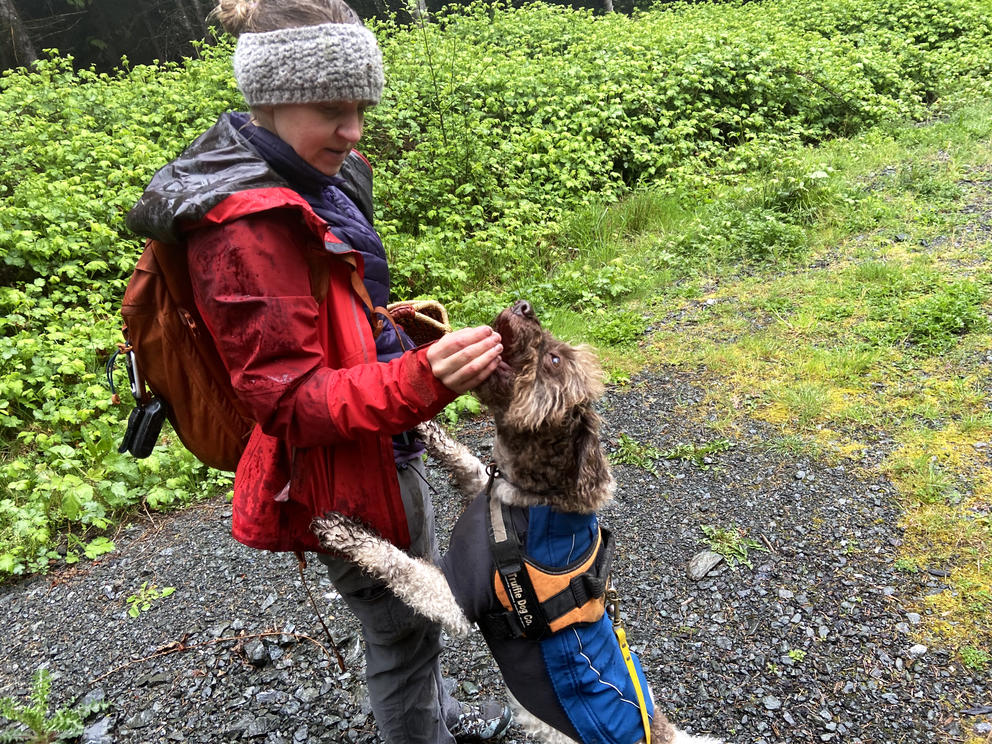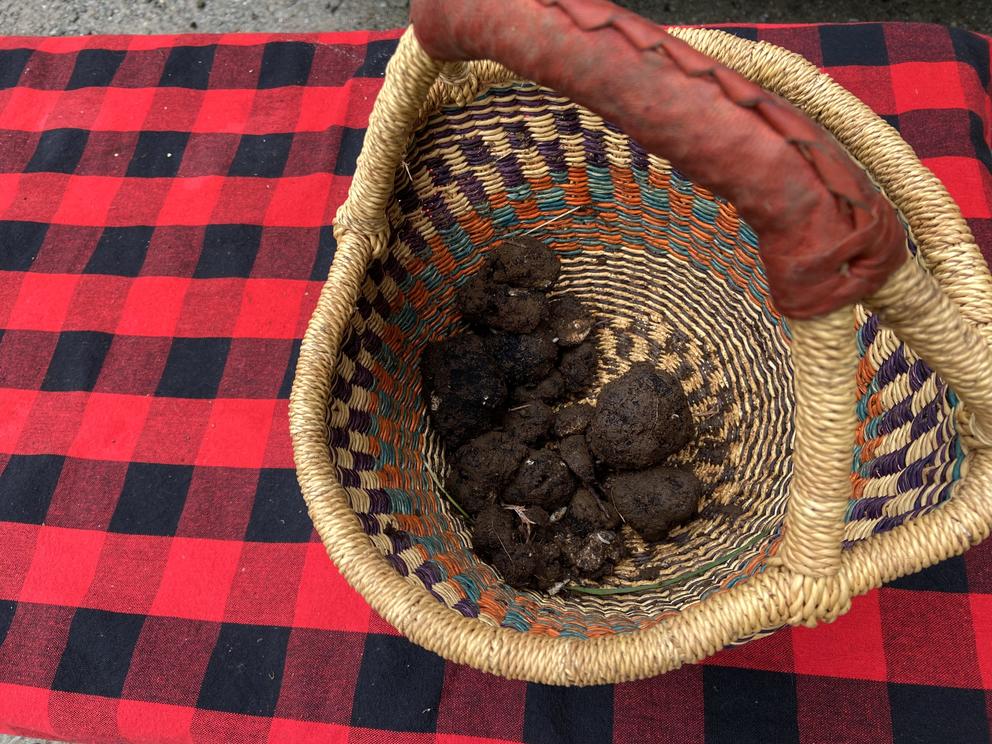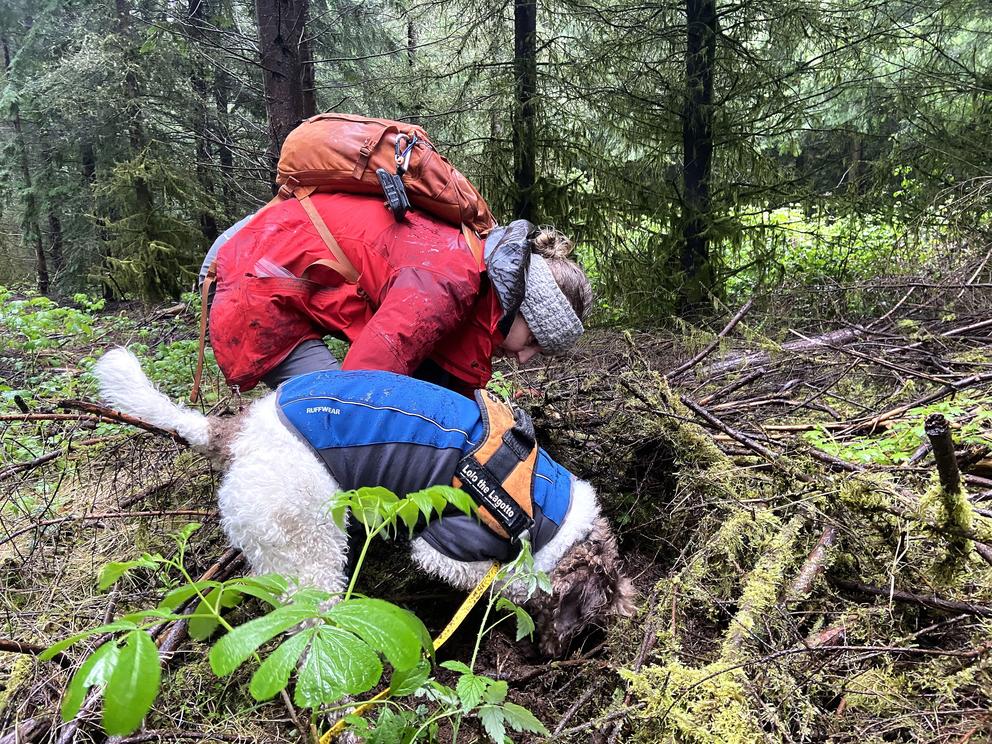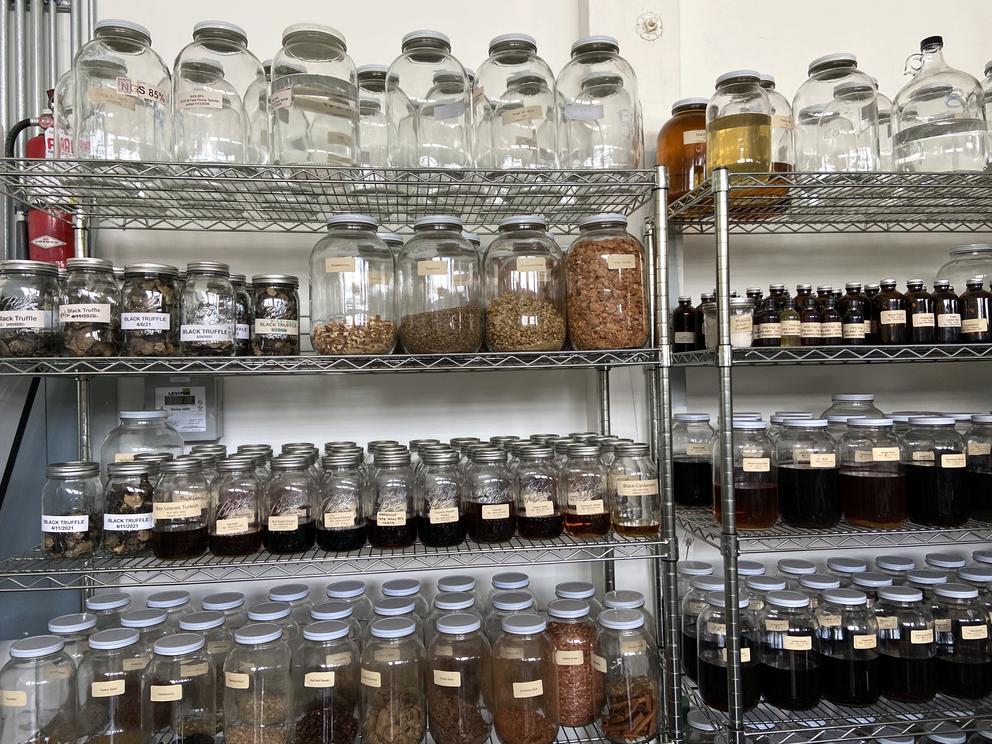But all those smells — undetectable to the human sniffer, or at least this allergy-suffering reporter — don’t matter to Lolo, a Lagotto Romagnolo. The Italian dog is hot on the hunt for black truffles.
“They’re often called Oregon black truffles, but we have quite a lot of them in Washington. They just beat us to the naming,” says Alana McGee.
Besides truffles, just about the only other scent the dog cares about is the bag of steak and chicken that Lolo’s human, McGee, carries in her pocket. The tasty morsels are dolled out as a reward each time Lolo sniffs out the fruity truffles, sometimes buried a foot underground.
It’s Lolo’s ninth birthday — hence, the steak.
“Last week my husband accidentally overcooked some tri-tip, so I cut some of it up for the dogs. They were pumped,” McGee says. “They actually work better for higher value treats. I’ve realized that they prefer steak, but I can’t do that every day.”
To get that steak, Lolo runs from truffle to truffle. To the untrained human eye, it appears she’s picking spots of grass or dirt beneath branches at random. But it’s taken years of training for Lolo to become so proficient at hunting down the fruity, floral-smelling fungi — she even finds one the size of a pea several inches underground.
“At this location the other week, she found one that was over a foot-and-a-half down,” McGee says.
Lolo taps her nose to the dirt and backs up. Often she’ll start to furiously scratch at the ground as McGee runs to catch up.
“Oh, right there? Hold on. Wait, please, wait. Where? Can you show us?” McGee calls to Lolo as she starts to dig.
McGee ferrets through the dirt until she finds Lolo’s treasure. She plunks the mud-covered fungus into a woven basket and repacks the dirt and grass. If she’s not fast enough, Lolo grows impatient, whining for her steak, sometimes trotting off in search of her next hidden gem.
Or, as McGee sits next to Lolo, a moment too late: “The problem with Lolo is if we don’t stay with her, she does that, which is eat them.”
Lagotto Romagnolo dogs have been used for truffle harvesting for hundreds of years in northern Italy. But, with a focus on training fundamentals, McGee says any dog, from Chihuahuas to huskies to Great Danes, can learn to sniff out the fungi. As a part of her business, Truffle Dog Company, she’s trained them all (and their humans) to search for truffles.
A Northwest delicacy
In the Northwest, truffles smell good not only to people and dogs; many animals also scarf on the delicacies. Wildlife such as deer, bear and squirrels spread the truffle spores around Douglas fir forests after they’re finished digesting.
The U.S. Forest Service’s Pacific Northwest Research Station documented more than 350 truffle species in the Northwest, including Northern California and parts of Idaho and British Columbia. The researchers say this region grows more types of truffles than any other place on the planet, except Australia. Some species are considered sensitive. People don’t eat many of the truffles that grow here.
“The Pacific Northwest has been a hotbed of evolution for the development of truffle fungi,” wrote Randy Molina, a retired botanist, in a newsletter after his 2009 report was newly published.
For culinary truffles, people may be most familiar with Italian white truffles or French or Périgord black truffles, delicacies that can fetch exorbitant prices per pound.
Three types of truffles are used for cooking in the Northwest: white, black and, less often, brown.
The 2009 report says the most common method of harvesting truffles in the region has contributed to a “lackluster” reputation for Pacific Northwest truffles. Often, rakes rip up the topsoil to expose the truffles underneath. Many of the raked fungi are not harvested at peak ripeness, as are their European counterparts, where dogs harvest the premium products.
“The sooner PNW truffle harvesters train and use dogs to harvest only ripe truffles, the sooner prices for premium Oregon truffles will approach their full potential, but overcoming a reputation for poor quality will take time,” the report reads.
In fact, the U.S. is one of the few countries in the world where truffles can be harvested with methods other than animals, McGee says.
“About 80% of the native truffles you’re going to find in the Northwest market are still not found by dogs,” McGee says, just as Lolo finds another truffle. “Oh, there it is. Good girl. Thank you. They are harvested via rake.”
McGee says dogs disturb a much smaller amount of the forest floor.
“[Raking] is really bad for the salmon streams, terrible for the forests. You go into an area that’s been raked, and it’s really just kind of devastating to look at,” McGee says.
Truffles can also be farmed — and can be raked there as well. McGee says Lolo is one of the few dogs in the U.S. that can hunt for truffles in the wild and on farms.
“Working on a truffle orchard, where they grow those European species, is much more akin to bomb detection or narcotics detection. It can be very tedious for the dogs, really strenuous. This is super fun for the dogs. So wild hunting they absolutely love. They get to run around and play in the forest and treasure hunt,” McGee says.
Sustainable harvesting
Sustainability is a big part of McGee’s harvesting. She initially discovered truffles in Italy. Then she moved home to the Northwest and found out truffles grew here, too.
While prime truffle hotspots are often tightly kept secrets, the most prolific sites are found in Oregon’s Willamette Valley, also home to the annual Oregon Truffle Festival, based in Eugene.
There was a small truffle harvesting industry in Oregon when McGee got into it, about 13 years ago. But not many people were harvesting truffles in Washington, especially not many people hunting down truffles with dogs.
McGee started training students — human and dog — once she had some truffle experience under her belt. That was about 10 years ago. She also sells truffles to local restaurants, harvesting them day-of and only as many as needed.
“We are only harvesting a small percentage of the truffles that are actually in the ground at any one time. And we’re only getting the ones that are ripe,” McGee says.
That ripeness means they need to be used quickly.
Liquid delicacy
A newer venture in Seattle is infusing the herbal liqueur amaro with truffles. Fast Penny Spirits sits on a shipyard in the city’s Queen Anne neighborhood. Friends Jamie Hunt and Holly Robinson opened up the distillery during the pandemic, featuring the Italian-style, after-dinner drink.
A cozy outdoor tasting area invites guests to sip on different styles of amaro. On a recent afternoon, a couple orders two glasses to sip. Hunt pours a bit of the Americano, a digestif-style drink.
“You’ll taste more of the black truffle, chocolate and the spices and earthiness,” Hunt says.
In the back of the distillery, tinctures and botanicals line the walls. A dehydrator dries out truffles for future batches, while a jar of the black bulbs sits nearby. The liqueurs are made out of local ingredients — from saffron harvested in Chelan County to regional Rainier cherries — and a litany of botanicals.
“We started figuring out the recipe by taking over 100 botanicals and tincturing them in alcohol,” Hunt says. “We just did a bunch of microtrials for the recipe so that we could do dozens a day and then figure out what’s working and what’s not.”
To help find more of the spendy fungi, Hunt is training her dog, Fiori, to sniff out truffles in Washington’s forests. At first, they played games where Hunt hid the truffles around her home. Now, Fiori has advanced to start searching the musty forest floor.
“You’re out here, and you’re trying to communicate and watching their behaviors, and they’re watching you. Well, actually, they’re not watching you that much,” Hunt laughs.
“You’d be surprised. Dogs are really in tune to people’s body language,” McGee says.
Fast Penny Spirits is able to use the truffles that aren’t pretty enough for restaurants, but that are still tasty and shouldn’t be wasted.
“To be able to work in sustainability with our production and look at new methods of creating spirits in a sustainable way, I think, is really important,” Robinson says.
Forest to fork
The market for Northwest truffles is growing. Prices have risen recently, as more dogs begin to harvest fresher fungi. On the low end, McGee estimates Northwest truffles could go for $400 per pound. The Oregon Truffle Festival says the Oregon fungi now sells for about $800 per pound.
Chefs – and distilleries – are starting to lean into the locally grown delicacies. Forest to fork, McGee says. And their uses are innumerable.
She ticks off a list: infused butter and eggs, pesto, pizzas, pastas, seafood — oysters are her favorite — infused cheeses and nuts, and vanilla ice cream, potentially the first truffle-based food she made.
“Our native black truffles lend themselves really well to dessert-type items,” McGee says.
Desserts? With a truffle? OK, I’m game. McGee picks out a handful of the fruity-smelling harvest, wraps them in a paper towel and hands them to me.
She arms me with some of her tried-and-true recipes, and I’m ready to test out this forest-to-fork thing. Thankfully, my roommate is also used to (bravely) dealing with my culinary experiments.
Back home in the Tri-Cities, I clean off the Western Washington dirt with an old toothbrush. Then I store them in my fridge alongside some Irish butter — as McGee advised, making the truffles work for me. Over the next day or so, they’ll infuse the butter and some eggs I’ve stashed in the airtight container.
Scanning through McGee’s recipes, I pick out the bread pudding. My sweet tooth is all in to try this new flavor combination.
Roughly 45 minutes and some truffle-infused milk later, the bread pudding is ready for its first bite.
“Moment of truth,” I say, scooping out a serving for my roommate.
Sara takes a few sniffs and examines the plate. She nibbles one bite, goes in for a second — this time aiming for the more floral-scented frosting.
“It’s good,” Sara says.
“Did you ever think you’d eat a truffle dessert?” I ask.
“I didn’t even know what a truffle was for quite a while. So, no,” she says.
(Don’t worry, you’re not alone in that. The 2009 truffle report says most people think of chocolates, not fungi. And if you’re still confused, turns out, truffle truffles are a thing.)
“I’ll be honest, it tastes kind of like a cinnamon roll. I’m into it,” she decides.
A truffle success — and the pesto I made with the remaining pieces was an even bigger hit.
Now that we're newly converted truffle fans here on the dry side of the Cascades, all we need is a dog to hunt our own.
This story was originally published at Northwest Public Broadcasting on May 19, 2021.






